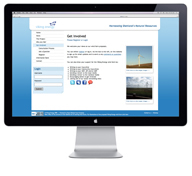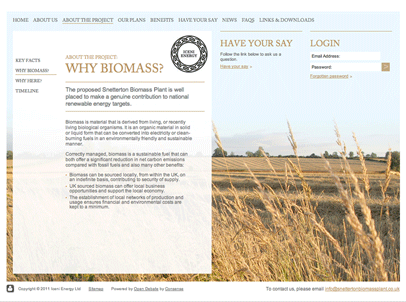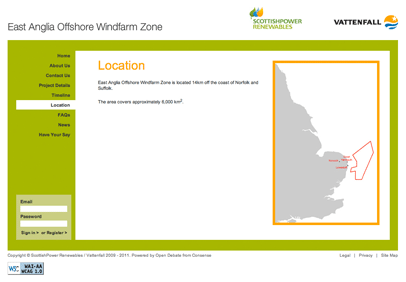Community Planning: Methods
Online consultation
- description
- more detail
- more pictures
Online consultation provides a channel of communication between a developer or government body that is accessible, convenient, interactive and auditable. Particularly useful for issues and projects that affect a large geographical area or large population such as major property developments and renewable energy projects. A good way to engage a broad audience in consultation, including people who do not typically get involved.
Issues and proposals are presented online in a user-friendly, visual, interactive way.
Visitors to the website are able to read and digest all information and proposals and then opt to make a response if they wish.
People wishing to respond register and provide some personal details so responses can be analysed.
Participants are given the option to be kept up-to-date via email about the consultation and the project.
A full audit trail of activity and communication is maintained.
Feedback is stored in a secure database where it can be viewed, responded to and reported on by the organisers.
Reports are generated on activity, feedback and key issues raised for further analysis.
Issues and proposals are presented online in a user-friendly, visual, interactive way.
Visitors to the website are able to read and digest all information and proposals and then opt to make a response if they wish.
People wishing to respond register and provide some personal details so responses can be analysed.
Participants are given the option to be kept up-to-date via email about the consultation and the project.
A full audit trail of activity and communication is maintained.
Feedback is stored in a secure database where it can be viewed, responded to and reported on by the organisers.
Reports are generated on activity, feedback and key issues raised for further analysis.
Photocredits:
Consense
Consense

Engaging online
Many people prefer to do as much as possible sitting at a computer.
Tips
- Run online community consultation alongside traditional community planning activities – such as workshops, exhibitions, postal surveys – to give everyone the chance to join in.
- Publicise online consultations well i.e. in local newspapers, newsletters and websites. Send personal invitations to key stakeholders, possibly with a special code to allow them to register more quickly.
- Keep information simple but make technical/planning documents available for download for those that want them.
- Ensure the registration process is quick and simple. Mostly just request a name, email address and postcode.
- Ensure your online questionnaire matches with your ‘offline’ questionnaire.
- Keep the online consultation content, and the people who have signed-up, regularly updated.
- Consider search engine optimisation, marketing and social media platforms to raise awareness of and drive visitors to online consultations.
- Ensure feedback can be reported on effectively, filtering where needed to drill down to the views of those most affected (e.g. certain postcodes) or to isolate key topics (e.g. visual impact, wildlife, access).
- Use interactive maps and masterplans or films to bring proposals to life.
Costs
A specialist company will be able to develop an online consultation system that you can update yourself using a simple publishing system and use to generate reports on feedback. Alternatively they will be able to update it for you for an additional charge.
Some systems can be used to store and manage all consultation data / feedback – not just that collected online.
Time may be required to update the site, send responses to questions, analyse the responses and provide feedback to registered users. Promotion can be incorporated into face to face engagement activities e.g. including the website address on materials, in press releases etc..
Average costs for a decent online consultation system: £5k to £15k. But could be up to £50k for top end site with multiple reporting capabilities.Sample contents of an online consultation website
- Home page
- About us (the developer or agency)
- About the place (where development is proposed)
- The proposals
- Benefits
- Planning history Issues (eg Housing, Environment, Energy)
- News
- Frequently asked questions (FAQs)
- Information bank (Links, Downloads)
- Have your say
- Register
- Contact us
Online consultation checklist
- Is the purpose of the consultation clear (how results will be used; what stage planning is at)?
- Is information presented in an easy-to-understand way, avoiding jargon and presented in relevant sections?
- Is it easy for people to register?
- Is the questionnaire unambiguous?
- Can people ask questions and opt to be kept updated via email as proposals evolve?
- Do all interested parties know about the opportunity for online consultation?
- Is the data collected in a secure and manageable way?
Inspiration
- “Informative website. I’m all in favour of anything which will help the environment and protect it for future generations”
- “Good luck. Simple community fund benefits could go a long way to engaging with locals. There is an awful lot of mis-information doing the rounds.”
- “It is fantastic to hear that there is a proposed windfarm. It is a much more efficient way of creating electricity than the usual power station method.”
-
“30.1 million adults in the UK (60%) use the internet every day or almost every day. The percentage rises to “99% for users aged 16 to 24.”

Get Involved page
For Viking Energy Wind Farm. Client: Viking Energy.
www.vikingenergy.co.uk

Project information page
For proposed Snetterton Biomass Plant. Client: Iceni Energy.
www.snettertonbiomassplant.co.uk

Developer information page
For the proposed Fordoun Sawmill Wind Turbine. Client: Galliford Try Renewables.
www.fordounsawmillwind.co.uk

Project location page
For East Anglia Offshore Wind Farm”. Client: ScottishPower Renewables.
www.eastangliawind.com
Photocredits
Illustrations courtesy of Consense, Viking Energy, Iceni Energy, Galliford Try Renewables, ScottishPower Renewables/ Vattenfall
Illustrations courtesy of Consense, Viking Energy, Iceni Energy, Galliford Try Renewables, ScottishPower Renewables/ Vattenfall